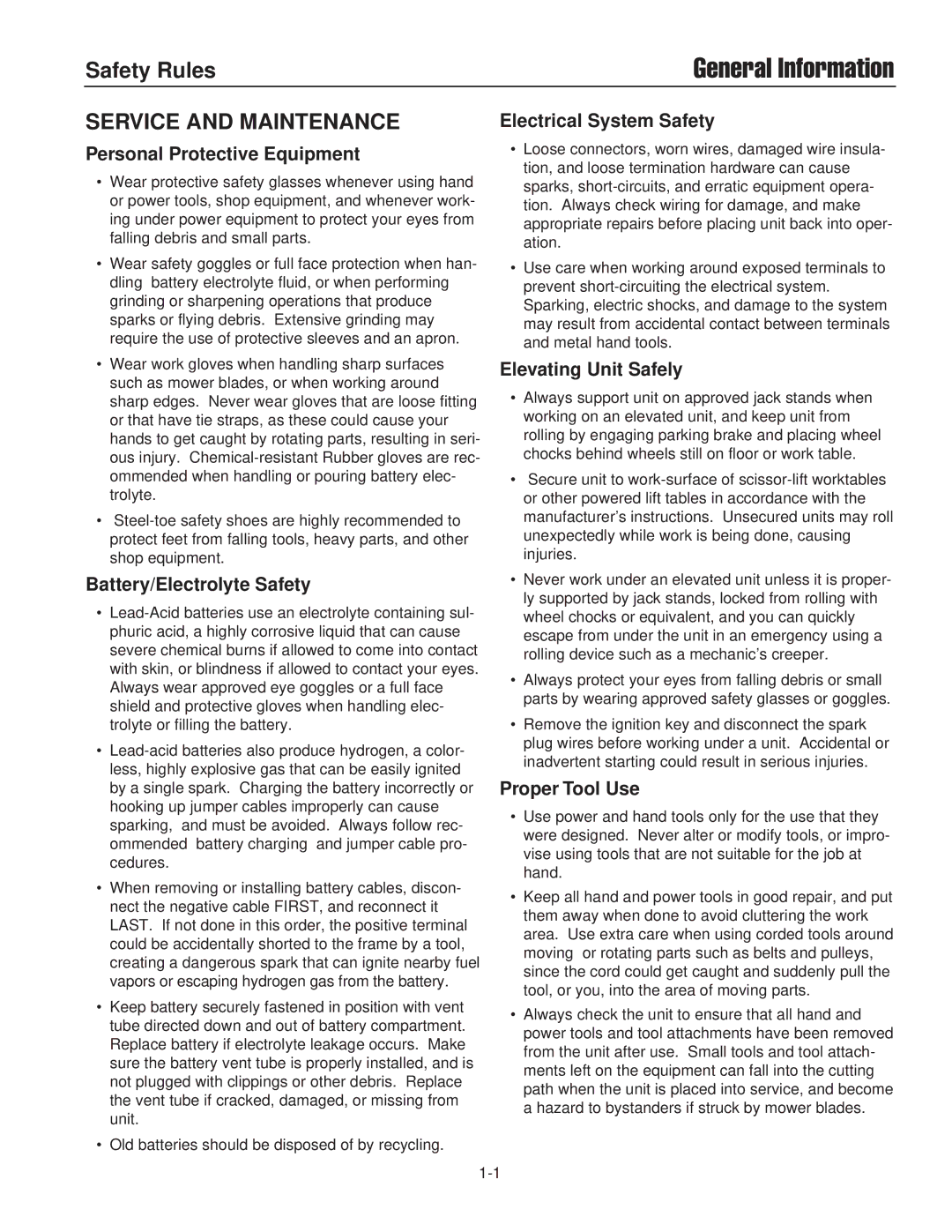Safety Rules | General Information | |
SERVICE AND MAINTENANCE | Electrical System Safety | |
Personal Protective Equipment | • Loose connectors, worn wires, damaged wire insula- | |
• Wear protective safety glasses whenever using hand | tion, and loose termination hardware can cause | |
sparks, | ||
or power tools, shop equipment, and whenever work- | tion. Always check wiring for damage, and make | |
ing under power equipment to protect your eyes from | appropriate repairs before placing unit back into oper- | |
falling debris and small parts. | ation. | |
• Wear safety goggles or full face protection when han- | • Use care when working around exposed terminals to | |
dling battery electrolyte fluid, or when performing | prevent | |
grinding or sharpening operations that produce | Sparking, electric shocks, and damage to the system | |
sparks or flying debris. Extensive grinding may | may result from accidental contact between terminals | |
require the use of protective sleeves and an apron. | and metal hand tools. | |
• Wear work gloves when handling sharp surfaces | Elevating Unit Safely | |
such as mower blades, or when working around | • Always support unit on approved jack stands when | |
sharp edges. Never wear gloves that are loose fitting | ||
or that have tie straps, as these could cause your | working on an elevated unit, and keep unit from | |
hands to get caught by rotating parts, resulting in seri- | rolling by engaging parking brake and placing wheel | |
ous injury. | chocks behind wheels still on floor or work table. | |
ommended when handling or pouring battery elec- | • Secure unit to | |
trolyte. | or other powered lift tables in accordance with the | |
• | manufacturer’s instructions. Unsecured units may roll | |
protect feet from falling tools, heavy parts, and other | unexpectedly while work is being done, causing | |
shop equipment. | injuries. | |
Battery/Electrolyte Safety | • Never work under an elevated unit unless it is proper- | |
• | ly supported by jack stands, locked from rolling with | |
wheel chocks or equivalent, and you can quickly | ||
phuric acid, a highly corrosive liquid that can cause | escape from under the unit in an emergency using a | |
severe chemical burns if allowed to come into contact | rolling device such as a mechanic’s creeper. | |
with skin, or blindness if allowed to contact your eyes. | • Always protect your eyes from falling debris or small | |
Always wear approved eye goggles or a full face | ||
parts by wearing approved safety glasses or goggles. | ||
shield and protective gloves when handling elec- | ||
| ||
trolyte or filling the battery. | • Remove the ignition key and disconnect the spark | |
• | plug wires before working under a unit. Accidental or | |
inadvertent starting could result in serious injuries. | ||
less, highly explosive gas that can be easily ignited | ||
Proper Tool Use | ||
by a single spark. Charging the battery incorrectly or | ||
hooking up jumper cables improperly can cause |
|
sparking, and must be avoided. Always follow rec- | • Use power and hand tools only for the use that they | |
were designed. Never alter or modify tools, or impro- | ||
ommended battery charging and jumper cable pro- | ||
vise using tools that are not suitable for the job at | ||
cedures. | ||
hand. | ||
• When removing or installing battery cables, discon- | ||
• Keep all hand and power tools in good repair, and put | ||
nect the negative cable FIRST, and reconnect it | ||
them away when done to avoid cluttering the work | ||
LAST. If not done in this order, the positive terminal | ||
area. Use extra care when using corded tools around | ||
could be accidentally shorted to the frame by a tool, | ||
moving or rotating parts such as belts and pulleys, | ||
creating a dangerous spark that can ignite nearby fuel | ||
since the cord could get caught and suddenly pull the | ||
vapors or escaping hydrogen gas from the battery. | ||
tool, or you, into the area of moving parts. | ||
• Keep battery securely fastened in position with vent | ||
• Always check the unit to ensure that all hand and | ||
tube directed down and out of battery compartment. | ||
power tools and tool attachments have been removed | ||
Replace battery if electrolyte leakage occurs. Make | ||
from the unit after use. Small tools and tool attach- | ||
sure the battery vent tube is properly installed, and is | ||
ments left on the equipment can fall into the cutting | ||
not plugged with clippings or other debris. Replace | ||
path when the unit is placed into service, and become | ||
the vent tube if cracked, damaged, or missing from | ||
a hazard to bystanders if struck by mower blades. | ||
unit. | ||
| ||
• Old batteries should be disposed of by recycling. |
| |
|
